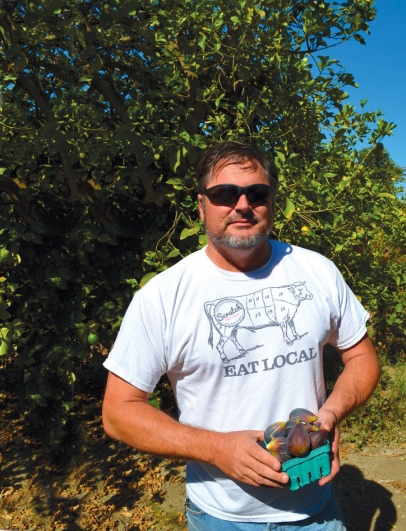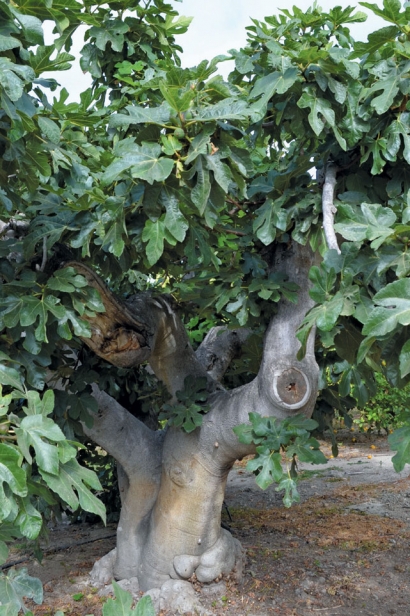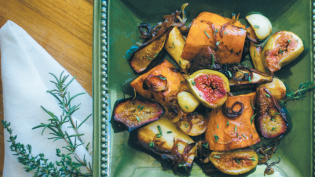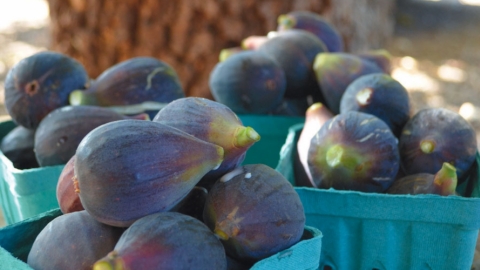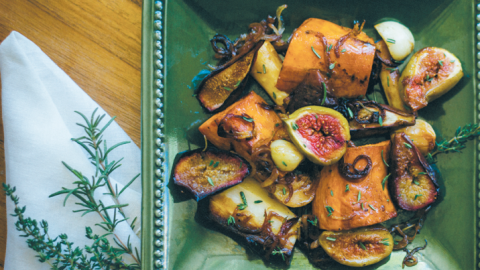Go Fig: How Chris Sayer Woos This Delicate Fruit
Figs have been around since time immemorial, thought to be first cultivated in Egypt or Arabia, likely between 4000 and 2900 BC. Similarly, the history of Harry, the oldest fig tree on Petty Ranch in Saticoy, is something of an enigma.
While Chris Sayer, co-owner of Petty Ranch, dates the imposing tree's planting to approximately 90 years ago, it has only recently received the attention and acclaim it deserves.
"The family lore is that my great-grandfather, Harry Pardee, planted the tree. The tree was called 'Harry's tree' and has become 'Harry' itself," says Sayer. "For years we just sort of ignored it and it grew."
The soft-spoken, easygoing Sayer makes something of an understatement while referring to Harry's growth. Visitors to Petty Ranch, which has been in the family five generations, are quite taken by the sight of Harry, whose trifurcated trunk is massive and branches – thick as a weight lifter's arm – boast an abundance of enormous dark-green leaves.
Then, of course, there are the figs, which are distinctively – well – Harry-flavored. They are presumably the Black Mission variety, but with an archaic twist, possibly due to the age of the tree, the type of soil and other indeterminate factors, says Sayer.
"One day, about six or seven years ago, I took some figs to [chef ] Tim Kilcoyne from Sidecar [restaurant] and he said 'Where did you get these? How many more do you have? Do you have varieties?'" says Sayer. "More and more people were asking about them and we thought 'There's an opportunity, potentially, here.'"
Kilcoyne used the figs from Harry's tree at Sidecar in Ventura. After the restaurant's closing, he's continued to acquire different fig varieties from Sayer for menu items on his food truck, Scratch. One of his popular recipes is a lime-and-butter grilled sea bass taco with fig salsa, which he serves seasonally.
Kilcoyne enjoys them all, but the Brown Turkey fig is one of his favorites when it comes to flavor balance and versatility.
"They're good in sauce, they're good fresh and when they're perfectly ripe, and you cut them open, the inside is so beautiful they're perfect for garnishing as well," says Kilcoyne. "You don't need to do much to them because they're delicious as is. Whenever I get a delivery of figs, I can't help myself but to eat three or four right away."
The path to Petty Ranch has been circuitous for Sayer, a former Navy lieutenant. After a naval career that included piloting P-3 Orion search aircraft, Sayer and his wife, Melissa, an attorney, settled in Silicon Valley, where he worked for an executive search firm specializing in dot-com companies.
"In 2001, we talked about how we always thought we'd like to come back to Ventura County and it'd be a great place for the kids to grow up," says Sayer. "Things finally started to fall into place."
The Sayers, who have two sons, Stephen, 24, and Jon, 18, now live on their ranch in Santa Paula. Sayer spent much of his youth at the Saticoy ranch managed by his stepfather, Don Petty, until his retirement a few years ago, so it was natural for him to re-enter the family business. Now, Sayer and his business partners – including his mother, and siblings – are responsible for the success of Petty Ranch, which primarily produces lemons and avocados on its 52 acres. (Don Petty passed away in June.)
It may become another site for growing figs, Sayer says.
"Santa Paula's warmer microclimate could give us fruit a few weeks out of sync with Saticoy," he explains.
It is the 600 fig trees, however, that have become quite the showstoppers.
In 2010, encouraged by the enthusiastic welcome of Harry's figs, and with an open area of four acres to fill, the partners decided to try growing figs, an uncommon crop in Ventura County.
"We had some lemons we wanted to retire, but we didn't want to put citrus or avocados in that particular spot," says Sayer. "So we planted that acreage into figs after leaving it dormant about a year and a half and cover-cropping it to build the soil."
The clay-like soil can be especially tough for digging, so Sayer and foreman Carlos Ortega, a ranch employee since 1972, planted a special blend of grasses as a cover crop. The grasses, which include barley, ryegrass and crimson clover, help open the ground for the fig trees' roots, as well as add a level of erosion control on top, and a soft soil beneath the surface for beneficial earthworms to proliferate. (For maximum biodiversity, at times, Sayer has also grown mustards, Sudan grass and beans.)
Now three years old, the trees, which comprise eight varieties – not counting Harry, which is in another part of the ranch – will take up to seven years to fully mature.
"The Desert King variety continues to really impress us. I feel it clearly has the best commercial potential of all the varieties," says Sayer, adding that they now have more of this green-skinned fig planted than any other.
While the fig trees are young, they're irrigating them at the same volume that they use for citrus to help them get established.
Petty instituted a water-efficient irrigation system over two decades ago, so the ranch is ahead of its time in terms of adapting to drought conditions. It is also to their benefit that the ranch has its own well and that the land in Saticoy sits over a basin that is less impacted by water shortages.
Sayer says he and his partners hope to eventually dial back the water usage by about half, knowing the trees will survive and the fig production numbers will still be excellent. The biggest hurdle remains the fig trees' worst enemy: the gopher, which can kill a young fig tree overnight by eating its roots. Other than that, figs are a hardy crop, able to survive temperatures as low as 10° and as high as 110°.
Although not considered fully mature, the 600 trees at Petty Ranch still produce enough figs during the season, which is typically late summer to the first frost, to provide fruit for local restaurants, chefs and caterers.
Among the fig fans are Tina Thayer and Kelly Briglio, owners of Paradise Pantry in Ventura.
"What I like about figs is they're one of the things out there that's truly seasonal," says Thayer. "They're so delicate that they can't be picked too early."
According to Briglio, accurate timing is among the most critical requirements for the perfect fig.
"His come to us impeccable – perfectly picked, perfectly ripe – and using them is my favorite part of the year," says Briglio. "Chris's figs are absolutely the best when it comes to overall consistency. He's very careful and he has a passion for what he does."
At Paradise Pantry, Chef Briglio stuffs Brown Turkey figs with Rogue Creamery Smokey Blue Cheese and toasted hazelnuts, and then wraps them with La Quercia speck (a sweet, smoky cured pork).
Pleased with the reception the figs are receiving from local chefs and their patrons, Sayer is continually seeking ways to expand his figs' usage, including an unusual experiment proposed by Four Brix Winery in Ventura.
"We have wanted to find ways for Four Brix Winery to work with more local growers," says Karen Stewart, proprietor of Four Brix.
"One of those growers we met, Chris Sayer, talked about his crops and his figs. So my husband, Gary, our winemaker, and Chris tossed around some crazy idea about making a fig port. This happened quite rapidly from discussion to harvest. All of sudden we have some Touriga Nacional grapes – a grape commonly used in making port wines – and three types of figs from Chris's farm."
Four Brix Winery has made a Grenache-based port-style wine for many years, so Gary felt the fig port would be a worthy challenge. The figs and grapes were harvested last fall and port needs to age at least year, which means it will take some time to see if the fig port is a success. (They're hoping to release it in 2015.)
Meanwhile, Sayer is also looking into teaming with a professional processing company to turn the figs into jams and other products. He also has his sights set on some citrus trees that may have to retire over the next few years, in contemplation of planting more figs – as a business decision, as well as a welcome delicacy for fig aficionados countywide and, eventually, beyond.
"We had been looking for a third crop, anyway, as a diversification strategy. We were looking around trying to find what that third leg on the stool might be, and figs fit the bill," says Sayer. "I thought there was the opportunity to make a connection with something different that other people didn't have."


